Elad Lassry solo exhibition.
White Cube Hong Kong (50 Connaught Road, Central, Hong Kong). Nov 23, 2012 – Feb 9, 2013
In a gallery space measuring a couple thousand square feet, exhibiting works of roughly the dimensions of a magazine page would seem to be incompatible with the economics of spatiality, not least in a city with rent prices ranking amongst the highest in the world. When the name Elad Lassry pops up, however, the dialectic of size suddenly makes sense. The LA-based artist is famous for producing framed pictures that do not exceed the conventional dimensions of a magazine page, roughly 14 x 11 inches, in an aspect ratio that builds the contemporary visual sensibility of an image in material form. For his solo exhibition at White Cube in Hong Kong, the walls in the ground floor space are embroidered with a line of Lassry’s photographs, including “Russian Blue” (2012), a C-print of a cat positioned in front of a turquoise background in a frame painted to a consistent tone. This chromatic uniformity is signature form of Lassry’s photography, where depth of field is replaced by the flat, monochrome plasticity of one dominant color. “Two Men, Grapefruits” (2012) also sticks to this aesthetic scheme: two men in navy blue, geared with perfect smiles, hold two mesh bags of grapefruits, resulting in a sharp contrast in color between the fruits — along with the faces of the two men — and the prevailing oceanic tone that imbues the image from center to frame.
Lassry’s works are usually small in scale, with the rare exception of “Women (065, 055)” at the High Line in New York, where an image of two women in a sea of green is mounted on a billboard. The audience witnesses a modesty of dimensions in the solo exhibition at White Cube, with photographs of the opening reception showing people viewing the works at a distance that appears too intimate. Magazine-sized images suggest an antipathy towards the monstrous installations that have conquered parts of the art world, but they also reveal an ambition to investigate how modern perception is constructed by consumer images produced and consumed with extreme speed. Although Elad Lassry notes in an interview printed in Frieze magazine (issue 143) that he does not think of himself as a photographer, the artist is obviously seen as a representative of new photography, as demonstrated by his participation in exhibitions engaging with new ontological narratives of the medium including “New Photography” (2010) at the Museum of Modern Art and “The Anxiety of Photography” (2011) at the Aspen Art Museum. This recognition stems from his ambitions with regard to consumer images, making his works “photography about photography.”
The artist is, of course, not the first investigator of this question. Numerous theorists and photographers have contributed their efforts in discussing how photography shifts human sensory boundaries and distributions of the sensible with its mechanical gaze, particularly with regard to the camera as something more than an honest Cyclops-machine that reproduces reality. Surprisingly, many such comments on photography critique its participation in the production of mass culture, implying the vanishing of singularity — understood as the quintessence of art for many. Walter Benjamin, in his essay “The Work of Art in the Age of Mechanical Production,” complained about the withering of the authenticity and singularity of art, which he called aura, as it was ground away by the motions of reproduction in photography. Susan Sontag, in her text On Photography, declares in her epigram that “all photographs are memento mori,” as the reproductive nature of photographic images reminds us not only of our mortality but also of the exile of the “having-been” from objective time and human experience through the freezing of the camera capture. Objects steeped in the eternity of a photograph see their qualities folded and locked in a certain perspective of the photographic gaze, becoming notes that are exclusive to our sensual contact. The single-eyed mechanical vision is capable of transcending the visual capacity of our flesh, a remarkable component that marks contemporary visuality of what can be seen, even passively. This challenge, of a machine that leaves bare eyes idling in interpassivity through the omnipresence of the camera, is traumatic. Sontag saw the camera as a sublimation of the gun for a reason: shooting a photograph actually makes its literal sense, not only for the speed but also the violence.
In an era of hyperreality, production is reproduction and the map is the territory. When we can applaud Wade Guyton’s Epson prints, it is nonsense to blame repetition in contemporary art, for it actually unveils the cult of capitalism as characterized by a cancerous body-without-organs. It is normal, then, when Elad Lassry invests his contemplation in the picture as an object rather than examining aspects of its mechanical reproduction, his works are often described as between photography and object, or becoming-object. In the artist’s own words, his artistic practice involves “making sculptures that happen to be photographs” (Frieze magazine). One explicit example of this intention occurs in “Untitled (Zebrawood Picture, Taupe)” (2012), where a zebrawood panel with objects made of abstract painted rosewood bearing the shapes of a sausage and pearl onions pop up from a wooden plane. The sculptural quality of Lassry’s work, however, is more than an occasional adoption of a two-and-a-half dimension. To the contrary, it is reified in the flatness and plasticity of his photos, created through the frequent use of straight-on shots that remind people of advertisements, fashion shoots, or food photography, characterized as they are by an emphasis on form. And the flatness of the images does not remain only on a visual level: Lassry also makes explicit efforts to avoid historical and political connotations in his pictures, as the viewer’s intention of diving into hermeneutic depths is blindfolded by the rich void of the mono-hue in the images.
